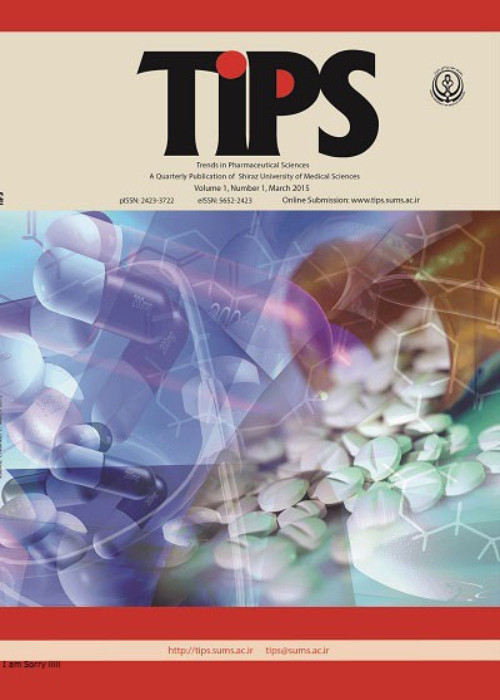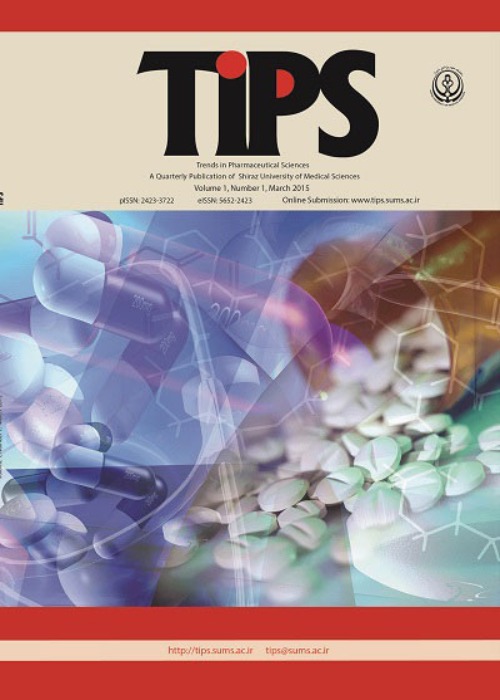فهرست مطالب

Trends in Pharmaceutical Sciences
Volume:9 Issue: 3, Sep 2023
- تاریخ انتشار: 1402/06/10
- تعداد عناوین: 8
-
Pages 169-170During their service as a faculty member, each pharmacy professor is faced with various duties including: teaching in the field of expertise, interdisciplinary research, executive responsibilities, and activity in the field of pharmacy, industry, or hospital. The important issue is whether all these activities or a part of them can ultimately lead to the excellence of the professor by meeting at least one exceptional need of the society.The late Dr. Ghasemi Dehkordi (1952-2023), our previous professor at the Isfahan Faculty of Pharmacy, mainly focused on the standardization protocols of medicinal plants during his academic activity (up to 2016). He did management a group of pharmacognosists, botanists, pharmacologists and related disciplines responsible for the compilation of Iranian herbal Pharmacopoeia.Isfahan, which was once the historical origin of the transfer of part of pharmacopoeial knowledge to the West through the Latin translation of a Persian manuscript of Qarabadin Irani in 1681, Pharmacopea Persica, once again gained the centrality of compiling the Iranian pharmacopoeia. A valuable work that must continue, and for that mentees are needed with the same dedication as the late mentor Dr. Ghasemi DehkordiKeywords: Mentoring, Iranian Herbal Pharmacopoeia, obituary
-
Pages 171-182With the emergence of the COVID-19 pandemic, a large number of patients required hospitalization and intensive care unit admissions. Patients with pre-existing medical conditions were associated with a higher chance of severe disease. On the other hand, medication errors in part resulting from polypharmacy are commonly observed in hospitalized patients. At the time of the Delta variant peak and the high influx of COVID-19 patients to the hospitals, clinical pharmacy ICU ward rounds were implemented to detect, and prevent medication errors to improve patient safety and care. Patients with known COVID-19 infection that were admitted to the ICU for a duration of 4 months were included in this prospective study. Every day (Saturday to Thursday) ICU patient rounds was performed by the clinical pharmacist. Medication reconciliation was done for all patients to detect probable drug omission or duplication during admission. Pharmaceutical Care Network Europe Foundation (PCNE) classification was used for classifying drug-related problems. A total of 86 patients were evaluated for medication errors during ICU admission. A total of 398 drug-related comments were given and 90% of the interventions were accepted by the attending physician. The most common medication error was attributed to overdosage of medications, mostly glucocorticoid therapy. The survival rate amongst patients was 56.1%. Clinical pharmacy interventions and medication reconciliation at times of pandemics can help towards improvement of clinical practice, patient safety, and saving of medication resources. Early detection of medication errors by clinical pharmacists can prevent further patient complications and death.Keywords: Clinical Pharmacy, COVID-19, Medication reconciliation, Medication errors
-
Pages 183-190Despite extensive research on antimicrobial drugs, efforts to find suitable alternatives to older drugs have not been very successful yet, due to microbial resistance. Heterocycles including azole and pyrimidine derivatives were used to design antimicrobial activity in this research, 12 novel pyrimidine-azole derivatives (3a-3l) that were previously synthesized were screened for their antibacterial and antifungal activities by using CLSI standard method. In this study, we used four species of bacteria, seven species of fungi, and five species of yeast. Molecular docking studies were also performed to investigate their binding mode and orientation toward lanosterol 14-α- demethylase (CYP51), as a plausible mechanism of azole antifungal compounds. The biological results showed that none of the compounds had antibacterial and antifungal effects compared to the control drugs. The molecular docking study showed that the compounds had a low binding affinity in the active site of the lanosterol 14-α- demethylase target, which confirmed the weak antifungal and antibacterial activities of these compounds.Keywords: Antimicrobial, molecular docking, Azole-Pyrimidine hybrids
-
Pages 191-202A series of 3,4-dihydropyrimidine-2-one derivatives were designed and synthesized as monastrol analogs by Biginelli cyclocondensation of a β-keto compounds and aromatic aldehyde with urea or thiourea. Biginelli cyclocondensation usually produces racemic mixtures of 3,4-dihydropyrimidine-2-ones. Enantiomers of 3,4-dihydropyrimidine-2-ones (R and S) often show different biological activities and may even have an opposite action profile. Therefore, developing of the stereoselective synthesis of 3,4-dihydropyrimidine-2-ones is one of the priorities of medicinal chemistry. Following observed diverse pharmacological effects of monastrol, 3,4-dihydropyrimidine-2-ones as new anti-cancer agents are the pharmacological category which improve and decrease the side effects of dihydropyrimidines especially resistance to chemotherapeutic drugs. 3,4-Dihydropyrimidine-2-ones followed their anticancer effects by inhibiting the kinesin motor protein. Because of the specific function of these proteins in mitosis, targeting the Kinesin spindle protein (KSP, or Eg5) as the most dramatic target of the mitotic kinesin family open up an opportunity for the progress of more selective antimitotics with an improved side effect profile. These facts prompted us to investigate if the effects of inhibitory enantiomers (R and S) of 3,4-dihydropyrimidine-2-ones could possibly differ from each other. Therefore, molecular docking of both R and S stereoisomers of 3,4-dihydropyrimidine-2-ones and monastrol was performed to study the interaction between inhibitors and the kinesin spindle protein binding site. According to docking studies, S stereoisomer of D2 (SD2) has the best score among the synthesized compounds and shows probably more stable binding with the active site of the enzyme and can be considered as a candidate for biological evaluation.Keywords: 4-Dihydropyrimidine-2-one, Biginelli reaction, Kinesin motor protein, docking
-
Pages 203-212In adults with acute and chronic end-stage liver disease, liver transplantation (LT) is the only treatment option for these patients. On the other hand, one of the substantial causes of death in these patients is bacterial infection after transplantation, which should be considered as well as appropriate antibacterial treatment. For this reason, this study was designed to provide a multi-faceted review of different types of infections after transplantation and their treatment options during one year of experience in the largest LT center for adult patients in Iran. In this retrospective cohort study, records from all individuals over 18 years of age candidates for liver transplantation in Abu-Ali Sina hospital, Shiraz, Fars, Iran from 2018 March to 2019 March , were assessed. Demographic, laboratory, and clinical data were extracted in addition to the antimicrobial therapy. In this study, 412 patients included. 15.77% of patients were infected after transplantation, of which 61.17% of the isolated pathogens were gram-negative and 38.83% were gram-positive. The most common isolated gram-positive and gram-negative microorganisms include staphylococci (27.69%) and Klebsiella (27.69%), respectively. Urinary tract infection was the most common type of infection after transplantation in adult liver transplant recipients, and length of stay in ICU, length of hospital stay, length of mechanical ventilation are among the risk factors affecting bacterial infection after LT.Keywords: Liver transplant, Bacterial Infections, Antibiotics
-
Pages 213-220Taxanes are a class of potent anticancer agents used in different cancers. Their low water solubility is the major challenge in formulation development that leads to the use of surfactants and organic solvents which causes severe hypersensitivity reactions. In this study, paclitaxel (PTX) was conjugated to a water-soluble and biocompatible polymer, dextran, to enhance solubility. Levothyroxine was also conjugated to dextran to provide targeted delivery. The cytotoxicity was studied on HepG2 and A375 cell lines before and after treating cell lines with levothyroxine. Results showed approximately 1250-fold water solubility enhancement by dextran conjugation. Drug conjugates presented higher cytotoxicity on A375 cell lines than its free drug counterparts at 10 and 50 nM concentrations after 24 hours. Pre-treatment with levothyroxine decreased the cytotoxicity on A375 as an integrin receptor rich cell line but did not show any significant effect on HepG2 cells which is low in expressing integrin receptor. In conclusion, preparation of levothyroxine targeted dextran conjugate might be an effective strategy for PTX delivery to different cell lines.Keywords: Cytotoxicity, Conjugate, Dextran, L-thyroxine, Paclitaxel, solubility
-
Pages 221-236
This review describes the Food and Drug Administration (FDA)-approved antiparasitic drugs for sheep and goats in the USA updated to 2021. The emerging drug resistance is posing a significant burden for the treatment of parasitic infections in these small ruminants and the need for novel antiparasitic drugs is urgent. Sheep and goats are producing every year important resources such as milk and wool, among others. This work incorporates the OneHealth approach which focuses not only on human health, but also on animal health and the environment in an interdependent modus operandi. The dynamic equilibrium among these three sectors plays a fundamental role in general healthcare. Drug discovery (e.g., a novel benzimidazole recently identified) and drug delivery (incorporation of the antiparasitic agent into the proper carrier to increase effectiveness) have provided some promising results in recent time. This should go hand-in-hand with the scientific awareness. Education is key in spreading the word about the responsible use of antiparasitic drugs. The synthesis of the currently approved drugs will be provided including synthetic procedures which date from 1961 to 2021. More synthetic pathways, when available, will be described. Their mechanism of action and ecotoxicological data will be presented as well.
Keywords: Parasites, FDA, Drugs, Synthesis, Sheep, Goats -
Pages 237-238In the age of artificial intelligence (AI) and biomedical big data, network pharmacology represents a breakthrough in traditional medicine (TM) research. The emergence of interdisciplinary frontiers, such as bioinformatics and systems medicine, has led to a new pharmaceutical research generation that emphasize networks and systems (1) (2). In recent years, TM researchers have shown great interest in exploring AI technologies as an emerging discipline (3). The network pharmacology field has proven to be an effective means of elucidating the mechanisms of traditional herbal medicine and traditional pharmacy (4). The primary focus is to modernize TM by incorporating cutting-edge techniques in genomics, metabolomics, and systems biology. This will enable a fresh look at the knowledge and insights offered by TM (5). Systems biology, which takes a holistic approach, is a crucial research methodology for understanding the TM pharmacology. To successfully integrate systems biology into TM, it is necessary to combine computational technologies with holistic insights (6). By constructing a network of interrelated "herb-compound-target-pathway" relationships, this technique provides a holistic understanding of the mechanisms underlying traditional medicine. The integration of computational techniques into the network pharmacology has led to a significant improvement in the accuracy and efficiency of active constituent screening and target identification, surpassing previous levels of performance (4). On the other hand, there has been a gradual increase in the global studies of traditional medicinal plants due to their natural sources and wide variety. These plants are capable of complementing modern pharmacological approaches (7-10).Keywords: Network pharmacology, Traditional pharmacy, Persian medicine


